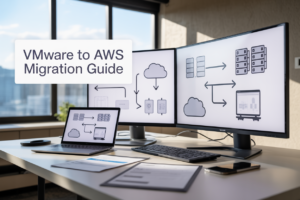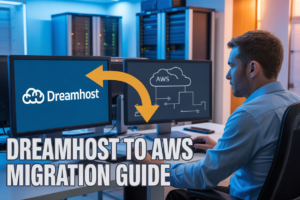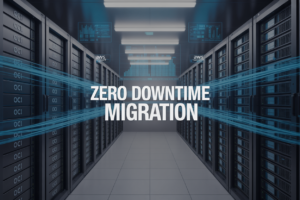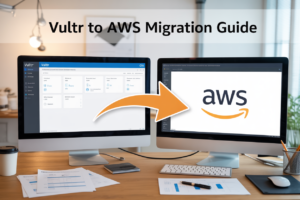Cloud governance has become the backbone of successful digital transformation, yet many organizations struggle with balancing security, compliance, and innovation in their cloud environments. This comprehensive guide is designed for IT leaders, cloud architects, compliance officers, and enterprise decision-makers who need to implement effective cloud governance without stifling their team’s ability to innovate and scale.
Poor cloud governance exposes organizations to security breaches, compliance violations, and operational chaos. When done right, a solid cloud governance strategy creates trust with stakeholders, maintains strict control over cloud resources, and ensures compliance across all regulatory requirements.
We’ll walk through the essential cloud governance fundamentals every organization needs to understand, including how to design a cloud security framework that actually works in practice. You’ll discover proven cloud governance best practices for building unshakeable trust in your cloud operations while establishing control mechanisms that protect your business without creating roadblocks for your teams.
We’ll also cover the practical side of achieving seamless compliance across different industries and regulatory environments. Finally, you’ll learn how to implement cloud governance that supports innovation rather than hindering it, ensuring your cloud governance implementation drives business value while managing risk effectively.
Understanding Cloud Governance Fundamentals
Define cloud governance and its critical role in modern business
Cloud governance represents the strategic framework that guides how organizations manage, secure, and optimize their cloud resources. This cloud governance strategy encompasses policies, procedures, and controls that ensure cloud operations align with business objectives while maintaining security and compliance standards. Modern businesses rely on robust cloud governance best practices to navigate the complexities of multi-cloud environments, where data sprawls across various platforms and services. Without proper governance, organizations face security vulnerabilities, cost overruns, and regulatory violations that can damage reputation and bottom lines.
Identify key stakeholders and their responsibilities
Enterprise cloud management requires collaboration across multiple departments, each bringing unique perspectives and expertise. IT teams handle technical implementation and security protocols, while finance departments monitor cloud spending and cost optimization. Legal and compliance teams ensure adherence to industry regulations, and business unit leaders define functional requirements. C-suite executives set strategic direction and allocate resources for cloud governance implementation. Security teams develop cloud security frameworks that protect against threats, while procurement manages vendor relationships and contracts. Each stakeholder must understand their role in maintaining effective cloud governance.
Recognize the cost of poor governance practices
Organizations without proper cloud governance face significant financial and operational risks that compound over time. Security breaches resulting from inadequate cloud risk management can cost millions in remediation, legal fees, and lost customer trust. Uncontrolled cloud spending leads to budget overruns, with shadow IT creating unauthorized resources that drain budgets unexpectedly. Compliance failures trigger regulatory fines and audit costs, while poor performance affects customer satisfaction and revenue. Data loss incidents damage brand reputation and may result in lawsuits. These consequences demonstrate why investing in comprehensive cloud governance pays dividends compared to reactive damage control.
Establish governance as a competitive advantage
Smart organizations transform cloud governance from a necessary overhead into a strategic differentiator that drives business value. Well-designed cloud policy management enables faster innovation cycles by providing clear guardrails that teams can operate within confidently. Strong governance builds customer trust through demonstrated security and compliance capabilities, opening doors to enterprise clients with strict requirements. Efficient resource management through governance reduces operational costs, freeing capital for growth initiatives. Companies with mature governance frameworks can scale operations rapidly while maintaining control, giving them advantages over competitors struggling with cloud complexity and risk management challenges.
Building Unshakeable Trust in Cloud Operations
Implement transparent reporting and monitoring systems
Real-time visibility into cloud operations builds trust through comprehensive dashboards that track performance metrics, security events, and resource usage. Automated monitoring tools should capture anomalies immediately while generating clear reports for stakeholders. Cloud governance best practices require establishing baseline metrics for system health, cost optimization, and security posture. Integration with SIEM solutions enables proactive threat detection and incident response. Regular audit trails provide forensic capabilities and demonstrate compliance readiness. Transparent reporting mechanisms ensure all team members understand system status and can make informed decisions about cloud governance strategy implementation across their enterprise cloud management initiatives.
Establish clear accountability frameworks across teams
Defining ownership structures prevents confusion during critical incidents and streamlines decision-making processes. Role-based access controls must align with organizational hierarchies while maintaining security boundaries. Cloud policy management requires designated owners for each governance domain including security, compliance, and cost management. Cross-functional teams need clear escalation paths and communication protocols. Documentation should specify who makes decisions about resource provisioning, policy changes, and incident response. Regular training ensures team members understand their responsibilities within the broader cloud governance framework. Performance metrics tied to accountability structures motivate consistent adherence to established protocols.
Create reliable backup and disaster recovery protocols
Robust backup strategies protect against data loss while meeting recovery time objectives across all cloud environments. Multi-region replication ensures business continuity even during major outages or natural disasters. Cloud risk management demands regular testing of recovery procedures to validate their effectiveness. Automated backup scheduling reduces human error while maintaining consistent protection levels. Recovery point objectives should align with business criticality of different workloads and applications. Documentation must detail step-by-step recovery processes for various failure scenarios. Multi-cloud governance considerations include cross-platform backup compatibility and vendor lock-in prevention. Regular recovery drills validate team readiness and identify potential weaknesses before actual emergencies occur.
Establishing Robust Control Mechanisms
Design comprehensive access management policies
Smart access management starts with the principle of least privilege—users get only what they need, when they need it. Role-based access controls (RBAC) form the backbone of effective cloud governance best practices, allowing teams to define granular permissions across different cloud services and resources. Identity federation connects existing directory services with cloud platforms, creating seamless single sign-on experiences while maintaining security boundaries. Multi-factor authentication adds another layer of protection, especially for privileged accounts accessing critical infrastructure. Regular access reviews help identify dormant accounts and excessive permissions that could create security gaps.
Deploy automated security controls and monitoring
Automation transforms cloud security framework implementation from reactive to proactive. Cloud-native security tools continuously scan for misconfigurations, unauthorized changes, and compliance violations across your entire infrastructure. Real-time alerting systems notify security teams about potential threats before they escalate into serious incidents. Automated remediation workflows can instantly fix common security issues like open storage buckets or misconfigured security groups. Security information and event management (SIEM) platforms aggregate logs from multiple sources, using machine learning to detect unusual patterns and potential threats that manual monitoring might miss.
Implement resource optimization and cost controls
Cost management becomes critical as cloud usage scales across enterprise cloud management environments. Automated tagging policies track resource ownership and business justification, making it easier to allocate costs to specific departments or projects. Right-sizing recommendations help identify over-provisioned instances that drain budgets without delivering value. Scheduled shutdown policies automatically power down non-production environments during off-hours, reducing unnecessary expenses. Budget alerts warn teams when spending approaches predefined thresholds, preventing surprise bills at month-end. Reserved instance planning optimizes long-term costs for predictable workloads.
Create standardized deployment and configuration processes
Infrastructure as Code (IaC) ensures consistent deployments across different environments and teams. Template libraries provide pre-approved configurations for common services, reducing deployment time while maintaining security standards. Version control systems track changes to infrastructure templates, enabling rollbacks when issues arise. Automated testing validates configurations before deployment, catching potential problems in staging environments rather than production. Configuration drift detection identifies when live systems deviate from approved baselines, triggering remediation workflows to restore compliance.
Establish change management and approval workflows
Structured approval processes balance innovation speed with risk management in cloud governance strategy implementation. Automated workflows route change requests through appropriate stakeholders based on risk level and affected systems. Emergency change procedures provide fast-track approval for critical security patches and urgent fixes. Change advisory boards review high-risk modifications that could impact business operations or compliance posture. Post-implementation reviews capture lessons learned and update approval criteria based on real-world outcomes, continuously improving the change management process.
Achieving Seamless Compliance Across Industries
Navigate regulatory requirements for your specific sector
Every industry faces unique compliance challenges when implementing cloud governance frameworks. Healthcare organizations must adhere to HIPAA regulations for patient data protection, while financial institutions navigate SOX and PCI-DSS requirements. Manufacturing companies deal with export controls and intellectual property regulations, and government agencies follow FedRAMP standards. Understanding your sector’s specific regulatory landscape allows you to build targeted cloud governance strategies that address mandatory requirements without overcomplicating your infrastructure.
Implement continuous compliance monitoring tools
Automated compliance monitoring transforms reactive audit responses into proactive risk management. Deploy cloud-native tools that continuously scan your environment for configuration drift, unauthorized access patterns, and policy violations. These solutions provide real-time alerts when resources fall out of compliance, enabling immediate remediation before issues escalate. Integration with existing SIEM systems creates comprehensive visibility across your multi-cloud governance structure, ensuring consistent policy enforcement regardless of which cloud provider hosts your workloads.
Document processes for audit readiness
Audit preparation becomes seamless when documentation lives alongside your cloud infrastructure. Maintain detailed records of access controls, data flows, security configurations, and incident responses in centralized repositories that auditors can easily navigate. Automated documentation tools capture changes in real-time, creating immutable audit trails that demonstrate continuous compliance efforts. Well-organized process documentation not only satisfies regulatory requirements but also accelerates internal troubleshooting and knowledge transfer across your cloud governance implementation teams.
Designing Your Cloud Governance Framework
Assess current cloud maturity and governance gaps
Start by mapping your organization’s existing cloud footprint across all departments and business units. Document current security policies, access controls, and compliance measures to identify where gaps exist. Review your team’s cloud expertise levels and existing governance processes. This baseline assessment reveals critical blind spots in your cloud governance strategy and helps prioritize improvement areas. Most organizations discover they have more cloud resources than initially realized, making this discovery phase essential for comprehensive governance planning.
Select appropriate governance tools and platforms
Choose cloud governance platforms that integrate seamlessly with your existing infrastructure and support multi-cloud environments. Look for tools offering automated policy enforcement, real-time monitoring, and detailed reporting capabilities. Popular enterprise solutions include Azure Policy, AWS Control Tower, and Google Cloud Asset Inventory. Third-party platforms like CloudHealth and Flexera provide cross-cloud visibility. Your selection should align with your technical stack, budget constraints, and team capabilities while supporting future scaling requirements.
Create policies that scale with business growth
Develop flexible cloud policies that adapt to changing business needs without requiring constant rewrites. Start with core security and compliance requirements, then build modular policy frameworks that can expand across new cloud services and regions. Use policy-as-code approaches to maintain consistency and enable version control. Create templates for common scenarios like new project onboarding, data classification, and resource provisioning. Well-designed policies should empower teams while maintaining necessary guardrails for risk management.
Establish metrics and KPIs for success measurement
Define measurable outcomes that demonstrate governance effectiveness across security, cost, and operational dimensions. Track metrics like policy compliance rates, security incident reduction, cost optimization savings, and deployment velocity improvements. Monitor resource utilization efficiency, unauthorized access attempts, and governance violation trends. Create executive dashboards showing governance ROI through reduced audit findings, faster compliance certifications, and improved operational reliability. Regular measurement ensures your cloud governance framework delivers tangible business value.
Implementing Governance Without Disrupting Innovation
Balance security requirements with development velocity
Finding the sweet spot between security and speed requires embedding governance checks directly into development workflows. DevSecOps practices integrate cloud governance best practices into CI/CD pipelines, allowing teams to catch policy violations early without slowing releases. Automated security scans and compliance checks run alongside code commits, giving developers immediate feedback. Policy-as-code tools enable security requirements to evolve with applications, ensuring cloud governance implementation doesn’t become a bottleneck for innovation.
Enable self-service capabilities within guardrails
Smart organizations create self-service portals where developers can provision cloud resources instantly while staying within predefined boundaries. Template-based deployments ensure every resource follows enterprise cloud management standards from day one. Developers get the freedom to innovate, while governance teams maintain control through automated approval workflows and spending limits. Pre-approved service catalogs streamline resource provisioning, reducing ticket queues and empowering teams to move fast within established cloud governance frameworks.
Foster collaboration between governance and development teams
Breaking down silos between governance and development teams creates better outcomes for everyone. Regular sync meetings help governance teams understand development needs while educating developers about compliance requirements. Cross-functional teams work together on cloud governance strategy, ensuring policies are practical and enforceable. Shared dashboards provide visibility into policy violations and remediation efforts, turning governance from a roadblock into a collaborative partnership that drives both security and innovation forward.
Measure and optimize governance effectiveness
Effective cloud governance requires continuous measurement and improvement. Key metrics include policy compliance rates, security incident frequency, and time-to-remediation for violations. Automated reporting dashboards track cloud risk management effectiveness across multiple environments, highlighting areas needing attention. Regular governance reviews analyze whether current policies support business objectives or create unnecessary friction. Multi-cloud governance success depends on adapting strategies based on real-world performance data, ensuring your cloud policy management evolves with changing business needs.
Cloud governance isn’t just another IT checklist item—it’s the foundation that makes or breaks your cloud success. When you get the fundamentals right and build strong trust through transparent operations, you create an environment where your team can innovate without fear. Proper control mechanisms and industry compliance don’t have to slow you down; they actually speed things up by eliminating uncertainty and reducing costly mistakes.
The real magic happens when you design a governance framework that works with your team, not against them. Smart organizations know that governance and innovation go hand in hand—one protects what you’ve built while the other drives you forward. Start with the basics, focus on building trust with stakeholders, and remember that the best governance feels invisible to your users while keeping everything secure and compliant behind the scenes.




















